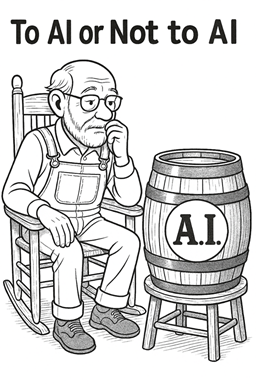You remember the Magic 8 Ball, right? That plastic sphere filled with dark liquid, hiding a 20-sided die printed with cryptic answers. You’d ask it a question, give it a shake, and wait for the window to reveal your fate. The responses ranged from confident—“Without a doubt” or “Yes – definitely”—to neutral—“Cannot predict now” or “Concentrate and ask again”—and sometimes downright discouraging: “Don’t count on it” or “My reply is no.”
When I first started diving into the world of Artificial Intelligence, I reviewed a presentation that unpacked the mechanics behind modern AI—especially the rise of Large Language Models (LLMs). It was fascinating, but oddly enough, it reminded me of something from my childhood: the Magic 8 Ball.
At the time, the Magic 8 Ball felt like magic. But looking back, it was just probability in disguise. Each of those 20 answers had an equal chance of appearing. No context. No learning. Just randomness.
Fast forward to today’s AI, and things look very different. As I listened to the theory behind LLMs—models that predict the next word based on statistical probability—it struck me: in a way, AI is like a supercharged Magic 8 Ball. But instead of random guesses, it employs engineered predictions based on context, patterns, and learned experience.
Probability: Uniform vs. Weighted
At a basic level, both the Magic 8 Ball and LLMs rely on probability. But the difference lies in how that probability is applied.
- Magic 8 Ball: Uses uniform probability—each answer has an equal chance of showing up.
- LLMs: Use weighted probability—some words are more likely than others, based on learned patterns from massive datasets.
This weighting is what makes LLMs intelligent. During training, they analyze billions of words to estimate the likelihood of certain word sequences. It’s a backward-looking process: the model learns from what’s already been written.
Prediction with Context
But when it comes to generating text, LLMs shift into forward-looking mode. They use probability distributions shaped by context—not just raw frequency. This is where the real magic happens.
Enter the transformer.
Transformers are engineered computational algorithms—specifically, neural network architectures—that power modern LLMs. They use a mechanism called self-attention, which allows the model to weigh the importance of each word in a sentence relative to every other word. This enables the model to understand context, nuance, and relationships between words.
So instead of blindly guessing the next word, transformers help LLMs make informed predictions that feel natural, coherent, and relevant.
From Toy to Technology
The Magic 8 Ball gave us random answers wrapped in mystery. Today’s LLMs give us context-aware predictions powered by deep learning and sophisticated algorithms. The magic hasn’t disappeared—it’s just evolved.
And while the Magic 8 Ball might still be fun at parties, it’s safe to say that AI has moved far beyond novelty. It’s now shaping how we write, communicate, and interact with technology every day.
Answers may vary. Stay curious,
Rick Ross
CEO – Chief Engineering Officer, and your confidential “AI Advisor”
SwitchWorks Technologies Inc.
Rick is an experienced IT consultant and a lifelong early adopter of emerging technologies. SwitchWorks Technologies Inc. is a digital engineering company helping organizations harness innovation to improve operations in meaningful, measurable ways. Have questions? Interested in finding out more about AI or other emerging technologies,? Feel free to ask Rick.






Leave a Reply